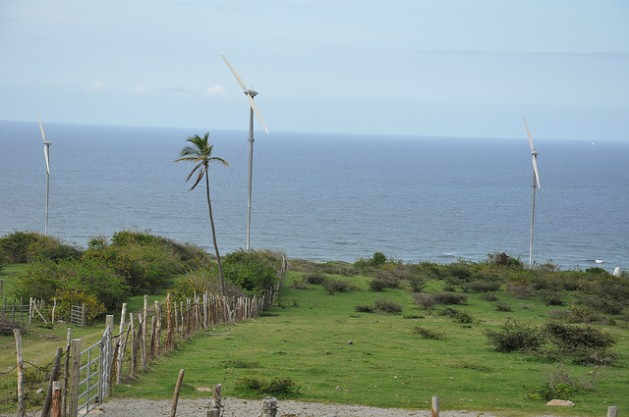
Latin America at a Climate Crossroads
Sep
17, 2014 - Analysis by Susan McDade - www.ipsnews.net
 |
| Turbines at WindWatt Nevis Limited. In most countries of the
region, the abundance of renewable resources creates an opportunity
to increase reliance on domestic energy sources rather than imported
oil and gas. Credit: Desmond Brown/IPS |
UNITED NATIONS, Sep 17 2014 (IPS) - World leaders
gathered at the Climate Change Summit during the
United Nations General Assembly on Sep. 23 will have
a crucial opportunity to mobilise political will
and advance solutions to climate change.
They will also need to address its closely connected
challenges of increasing access to sustainable energy
as a key tool to secure and advance gains in the
social, economic and environmental realms.
This is more important than ever for Latin America
and the Caribbean. Even though the region is responsible
for a relatively low share of global greenhouse gas
(GHG) emissions, 12 percent, according to U.N. figures,
it will be one of the most severely affected by temperature
spikes, according a World Bank Report.
For the Caribbean region in particular, reliance
on imported fuels challenges balance of payments
stability and increases the vulnerability of key
ecosystems that underpin important productive sectors,
including tourism.
And the region faces new challenges. Demand for
electricity is expected to double by 2030, as per
capita income rises and countries become increasingly
industrialised—and urban.
Although the region has a clean electricity matrix,
with nearly 60 percent generated from hydroelectric
resources, the share of fossil fuel-based generation
has increased substantially in the past 10 years,
mainly from natural gas.
Now is the time for governments and private sector
to invest in sustainable energy alternatives—not
only to encourage growth while reducing GHG emissions,
but also to ensure access to clean energy to around
24 million people who still live in the dark.
Importantly, 68 million Latin Americans continue
using firewood for cooking, which leads to severe
health problems especially for women and their young
children, entrenching cycles of poverty and contributing
to local environmental degradation, including deforestation.
Cities also need to be at the heart of the solution.
This is particularly important for Latin America
and the Caribbean, which is the most urbanised developing
region on the planet.
Urbanisation rates have jumped from 68 percent in
1980 to 80 percent in 2012. By 2050, 90 percent of
the population will be living in cities. This brings
about a different set of energy challenges, in particular
related to transport and public services.
Therefore, the question is whether the region will
tap its vast potential of renewable resources to
meet this demand or will turn towards increased fossil
fuel generation.
In this context, energy policies that focus not
only on the economic growth but also on the long-term
social and environmental benefits will be essential
to shape the region’s future.
Consequently, in addition to reduced CO2 emissions,
the region should favour renewables. Why? Latin America
and the Caribbean are a biodiversity superpower,
according to a UNDP report.
On the one hand, this vast natural capital can be
severely affected by climate change. Climate variability
also destabilises agricultural systems and production
that are key to supporting economic growth in the
region.
But on the other hand, if properly managed, it could
actually help adapt to climate change and increase
resilience.
Also, in most countries, the abundance of renewable
resources creates an opportunity to increase reliance
on domestic energy sources rather than imported oil
and gas, thereby decreasing vulnerability to foreign
exchange shocks linked to prices changes in world
markets.
In this context, countries have already been spearheading
innovative policies. Several countries in the region
produce biofuel in a sustainable way. For example,
Brazil’s ethanol programme for automobiles
is considered one of the most effective in the world.
Investing in access to energy is transformational.
It means lighting for schools, functioning health
clinics, pumps for water and sanitation, cleaner
indoor air, faster food processing and more income-generating
opportunities.
It also entails liberating women and girls from
time-consuming tasks, such as collecting fuel, pounding
grain and hauling water, freeing time for education
and paid work.
The U.N. Development Programme (UNDP) is working
with countries in Latin America and the Caribbean
to boost access to sustainable energy and reduce
fossil fuel dependency.
In Nicaragua, for example, nearly 50,000 people
from eight rural communities gained access to electricity
following the inauguration of a new 300 kilowatt
micro-hydropower plant in 2012.
This was a joint partnership between national and
local governments, UNDP and the Swiss and Norwegian
governments, which improved lives and transformed
the energy sector.
In addition to spurring a new legislation to promote
electricity generation based on renewable resources,
micro enterprises have been emerging and jobs have
been created—for both men and women.
Universal access to modern energy services is achievable
by 2030—and Latin America and the Caribbean
are already moving towards that direction. This will
encourage development and transform lives.
In a Nicaraguan community that is no longer in the
dark, Maribel Ubeda, a mother of three, said her
children are the ones most benefitting from the recent
access to energy: “Now they can use the internet
and discover the world beyond our community.”
Edited by Kitty Stapp
Read the orginal atricle: http://www.ipsnews.net/2014/09/latin-america-at-a-climate-crossroads/

|